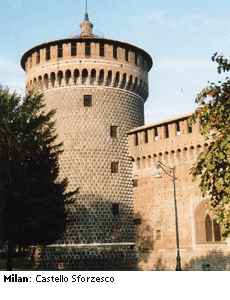
Milan Hotels

Reserve Milan Hotels: save up 70% on rooms!
Compare offers & book on line at hotel's web sites. |
|

|
|
Milan Guide Italy
History and culture
|
|
|
|
|
History and culture
The city’s origins date back to 400 B.C when the Gauls settled in this area of the Po Plains, having defeated the Etruscans who were by now in decline.
When the city was conquered by the Romans in 222 B.C. and annexed to the Empire, it was given the name Mediolanum. After some attempts at rebellion, it became a permanent Latin colony (89 B.C.) and then regional capital (15 B.C.). Over the years, Mediolanum acquired the name “Roma secunda” due to its strategic position. After 313 A.D., the year in which the Emperor Constantine issued the Edict of Tolerance towards Christianity, many churches were built and the first bishop was appointed: Ambrogio was such an influential person that the Church became the Ambrosian Church.
After the fall of the Roman Empire, Milan was left to the mercy of the Barbarians, until it was conquered by the Longobards (also known as Lombards) in 569 A.D. Towards the end of the eighth century, the bishops managed to use the influence to full extent, forcing an alliance with the emperors: Ottone of Saxony , who was crowned King of Italy in the Church of Sant’Ambrogio, made this power even more legitimate.
In the first half of the year 1000, The Archbishop of Milan became the most powerful political figure in the whole of Northern Italy. After a series of political problems, Milan became a municipality (1117), and gradually freed itself from the Archbishop. It also began to expand by declaring war on other municipalities in the nearby area. Later the attempt by Frederick I of Swabia to take over the city gave rise to the birth of the Lombard League, which fought for the city’s independence, and which ended in 1176 after the defeat of Barbarossa.
From 1200 onwards, Milan became an increasingly important city, and finally changed from being a municipality to a “Seigneury”. The city walls were extended, new buildings were built and roads were paved. The Visconti family, noblemen from Bergamo, Cremona, Piacenza, Brescia and Parma came to power in 1300 and brought about a lengthy period of splendor and wealth for the city. Monuments were built, including the famous Duomo in 1386, that soon became the city’s symbol. The Sforza family took over from the Viscontis, and with them they brought peace after many years of warring against Venice and Florence. Milan developed sciences, art and literature under the Sforza Duchy: Leonardo da Vinci and “il Bramante” were called to the Court of Ludovico il Moro. When Charles V came to the throne in 1535, the city began a period of almost two centuries of Spanish rule, which is narrated by Alessandro Manzoni in his classic book “I Promessi Sposi” (The Betrothed). At the beginning of the eighteenth century, the Austrians arrived in Milan: Milan underwent a deep cultural changed under Austrian rule. The La Scala Theater – where Giuseppe Verdi made his debut – was built, together with many Neoclassical buildings and the Arco della Pace. In 1859, the Austrians were driven out of Milan and the city was annexed to the Kingdom of Piedmont, which then became the Kingdom of Italy in 1861. Milan was immediately chosen as the economic and cultural capital of Italy, and has maintained this title up to modern days.
Go to directories of Web Sites
Go to itinerary:
|
|
|
|
|
Acquista la tua visibilità su Travel Plan
|
|
|
|




